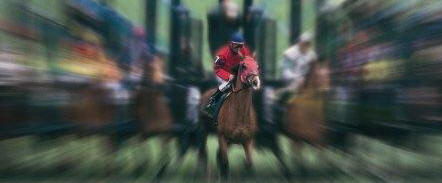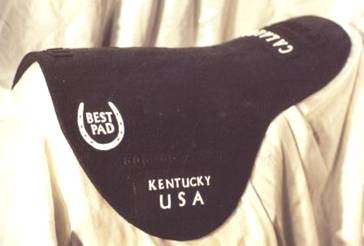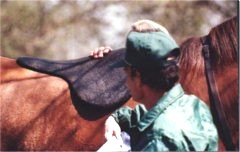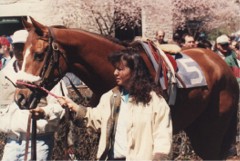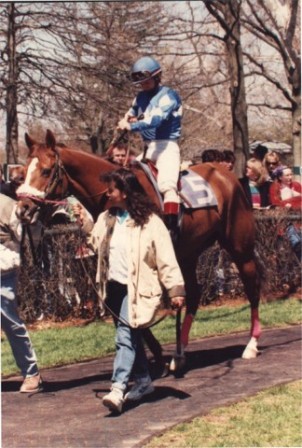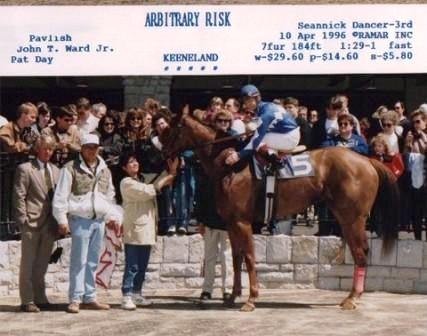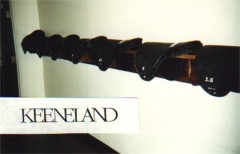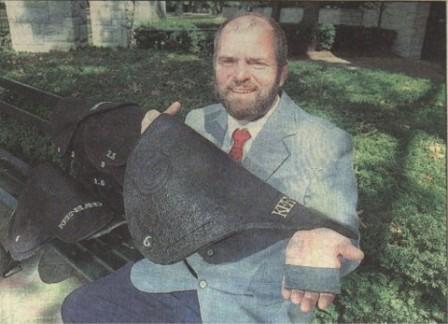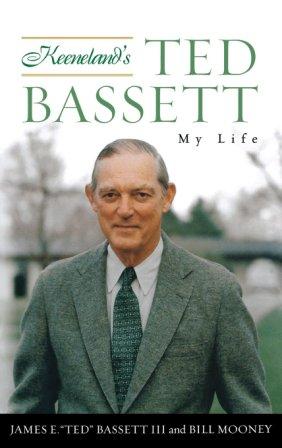Best Pad™ History
Home
Saddle Pads
Conditioning Weight Pads
Safety Padding
Contact Us
|
CONDITIONING WEIGHT, ENDURANCE WEIGHT and STEEPLECHASE PADS |
Below find a history of Best Pad™, “A Horse Story about Best Pad™” and an EXCERPT from Keeneland’s Ted Bassett My Life. A HORSE STORY about Best Pad™By Meg Davis-Bowling 9/6/96 AN IDEA IS BORNIt was during his years as a Kentucky State Racing Commission veterinarian that Dr. Philip Shrimpton noticed the impact of lead weights in thoroughbred racing. He witnessed firsthand the negative effects of the lead weights on some of the top horses in racing as they paraded anxiously around the Keeneland paddock and into the starting gate. As a scientist and former horse trainer, he recognized immediately the effects these chunks of lead had on both horse and rider. The lead weights focused the force of the race weight onto the horse's withers and back. They restricted the horse's shoulder movement, produced an altered gait, and caused direct injury to the horse's muscles. Post race examinations revealed that subsequent injuries and poor finishes resulted from these lead weights. When not working as a state veterinarian, Dr. Shrimpton and his wife, Catherine, were establishing an equine diagnostic and consulting company called Equine Environmental Consulting, Inc. This company's goal is to develop products and services for horse farms, training stables and race tracks that enhance the success and health of horses by improving their environment. As soon as Dr. Shrimpton recognized the lead weights as a problem, he began working on a solution. SOLVING A PROBLEM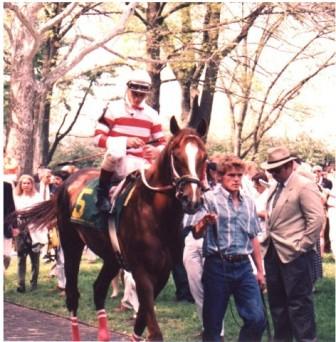
Through research and experience, Dr. Shrimpton identified the need for a pad for the standard thoroughbred racing saddle that satisfies the need for handicap weight without the use of lead. Equine Environmental Consulting, Inc. had already been producing several other types of saddle pads, and their product name was Best Pad™. This line of saddle pads included a light weight Best Pad™ Thoroughbred Race Pad. Dr. Shrimpton and his wife used their previous experience with saddle pads to develop a prototype of the Best Pad™ Race Weight Pad. Dr. Shrimpton developed a revolutionary high-density polymer to provide flexible weight. And they fashioned the pads using felt; vulcanized rubber and the high-density polymer to produce a set of black pads at varying weights. Besides eliminating the problems caused by lead chunks, Best Pad™ Race Weight Pads were designed to enhance the safety and comfort of the horse. Their textured surface grips the horse, distributes the race weight uniformly and lessens physical impediments caused by extra weight. Their rubber surface was designed to be slip-resistant, waterproof and durable. Created in the shape of the horse's back, the Best Pad™ Race Weight Pad provides maximum comfort for horse and rider. Dr. Shrimpton paid close attention to the important details that effect the horse's safety and performance when designing Best Pad™ Race Weight Pad. After in-depth field-testing and experimentation, the Race Weight Pad was ready to be brought to the public. JUDGMENT DAYKentucky Jockey Pat Day was the first to use the Best Pad™ Race Weight Pad in a race. He was riding a long shot named Arbitrary Risk at Keeneland's 1996 Spring Meet. The filly went on to win her maiden race in the Best Pad™, paid $29.60 and Pat Day became an instant fan of the new Race Weight Pad. Beginning that April day, Best Pad™ Race Weight Pads began steadily toward widespread national and international popularity.
Kentucky Jockey Pat Day and Best Pad™ 6# Race Weight Pad at Keeneland Spring 1996Jockeys and trainers alike recognized the advantages to eliminating lead weights from their saddles. Those who were concerned for the welfare of their horses took interest in this new and innovative product. Best Pad™ Race Weight Pads were used by various jockeys and trainers in all three Triple Crown races in 1996. Jerry Bailey won the Kentucky Derby with Grindstone while wearing a three-pound Best Pad™ Race Weight Pad. Mr. Bailey's support and belief in the pad lead E.E.C., Inc. to create several Race Weight pads specifically for his use with Cigar. Cigar with Jerry Bailey aboard tied Citation's record while using a six-pound Best Pad™ Race Weight Pad.
WINNERS: Pat Day with Best Pad™ Race Weight Pad'sFirst Race and First Win for Best Pad™ Race Weight Pads A GREATER GOALAs demand for the pads grew, Dr. Shrimpton and his wife began to conceive a greater goal for Best Pad™ Race Weight Pads. They realized that in order to make a real difference in the racing industry, these pads needed to become universal. Best Pad™ Race Weight Pads were created for the benefit of all racehorses and riders; they needed to become more available. Lead weights needed to become "a thing of the past," for the welfare of the horses. Dr. Shrimpton realized that since the racetracks provide the lead weights, they should be approached with the weight pads. So, Equine Environmental Consulting, Inc. a company based in the Bluegrass suggested a change from lead weights to Best Pad™ Race Weight Pads to Keeneland Association.
KEENELAND Takes the First Step for the BENEFIT OF ALLBest Pad™ Race Weight Pads had an immediate appeal to Keeneland Association primarily due to their interest in the well being of the horses. The fact that the pads replace the outdated lead chunks with effective padding, they are easily maintained and cleaned and they help prevent injuries due to added weight was enough for Keeneland. They ordered five sets of Best Pad™ Race Weight pads for their Fall 1996 Meet. Each set that Keeneland ordered contains a 1 lb. pad, a 1.5 lb. pad, a 2 lb. pad, a 2.5 lb. pad, a 3 lb. pad, a 4 lb. pad, a 5 lb. pad and a 6 lb. pad. A 7 lb. and an 8 lb. pad were also ordered for occasions when unusually high weights are needed. This range of Best Pad™ Race Weight Pads provides a great deal of flexibility for jockeys, as they need to adjust their handicap weights depending on the horse and the race. Equine Environmental Consulting, Inc. along with Keeneland worked together to develop a system of storage and easy access to the pads in the jockeys' quarters. This system makes the Best Pad™ Race Weight Pads available to all jockeys and their valets. With the over 40 pads that Keeneland ordered, the lead weights will become obsolete on the Keeneland track.
Dr. Shrimpton with Keeneland's Best Pad™ Race Weight Pads and a lead weight slabThis change can mean only good things for the horses, their jockeys and even the Keeneland crowds. The Best Pad™ Race Weight Pads ensure that the horses are more comfortable which in turn promotes more consistency in their running. Spectators and bettors will have fewer factors to consider when handicapping their favorite picks from the Keeneland stands. Keeneland's highest priority, however, is the welfare of the horses. Their acceptance of Best Pad™ Race Weight Pads proves their dedication to improving conditions for the animals in the thoroughbred racing industry. Their foresight in adopting this new method is encouraging to Dr. Shrimpton and his wife. They hope that ultimately, other racetracks will learn from the example set by Keeneland that lead weights need to be replaced with a kinder practice. Keeneland has taken the first step in the right direction with the Best Pad™ Race Weight pads, for the benefit of all. ~ ~ ~ ~ ~ Excerpt from Keeneland’s Ted Bassett My Life
Revolutionary concepts, especially ones pertaining to the welfare of Thoroughbreds and the people who handle them, always gain my attention. During the past seventeen years, I have shared a special friendship and working relationship with Dr. Philip E. Shrimpton and his wife, Catherine Davis. They are an intriguing couple, blessed with an intellectual curiosity and an extraordinary work ethic. Their goal is to make horse racing a much safer sport, and they have done so by inventing a new form of weight pads for jockeys and vastly improved padding for starting gates. I first met them following a speech I had given upon receiving the John H. Galbreath Award from the University of Louisville’s Equine Industry Program in 1992. During the question-and-answer session with students that followed the award ceremony, I conveyed the message that Keeneland was always seeking to explore new products and techniques. Phil and Cathy subsequently read a transcript of my remarks and made an appointment to meet with me. Phil has a veterinary degree from Ohio State University and had spent three years as state veterinarian for the Kentucky Racing Commission. “During that time, I examined over 10,000 horses on race days at various Kentucky tracks,” he told me. “I was at the starting gate for every race. I saw what went on.” Back then Phil and his wife were in the early process of designing cushioning weight pads for jockey. The pads would provide an alternative to the lead-carrying pouches riders had been required to carry for well over a century to comply with the weight assignment given to horses in a given race. The idea was to create pads that would fit comfortably over a horse’s back and distribute weight evenly. It didn’t take me long to grasp the merit of what Phil and Cathy were trying to do, and I told them that hence forth they could count on me to be in their corner. In the ensuing years, Keeneland became a laboratory for their work. There has been a lot of trial and error, modification, and revision. But the result is the development of Best Pad Race Weight Pads, made of felt vulcanized rubber, and high-density polymer that sit under the jockey’s saddle and completely replace the need for pouches containing lead bars. The pads range in weight from one to twenty-five pounds. Major American racetracks, including Keeneland, Churchill Downs, Del Mar, and Santa Anita, have purchased sets of them, and Hall of Fame jockeys such as Pad Day and Jerry Bailey purchased sets for their private use before they retired. And the race pads are now used in eleven foreign countries too, including Dubai, Hong Kong, and South Korea. Phil and Cathy are self-taught in the discipline of polymer chemistry (which involves condensing small molecules into a compound of higher molecular weight) and have used that knowledge in developing their padding for starting gates. Among other ingredient, this padding used “memory foam”, which was initially developed by the National Aeronautics and Space Administration (NASN) for space shuttle seats. Eight tracks, including Keeneland, currently utilize the padding, and it has reduced injuries (among horses, jockeys, and assistant starters) at the gate. And it has correspondingly reduced the number of “Gate scratches”, which can decimate wagering pools, especially when a favorite is involved. I will confess that Phil is not always easy to understand—his mind is forever at work, always thinking, assessing and analyzing. I recall having breakfast with him one morning in the Keeneland track kitchen, and Nick Zito sat down to join us. I introduced Phil to Nick an asked Phil to explain what he was doing. Phil started talking about polymers. And polyurethane, which is used with oil-drilling bits to reduce friction and is also used by Phil and Cathy to reinforce the skin of their starting gate padding. And memory foam. And the necessity of uniform weight distribution. The more Phil went on, the more technical he became. All the while, Nick sat there nodding his head. And I was nodding my head. And we both continued to nod our heads. Well, Phil eventually got up and left, and Nick then said to me, “General, I’m not sure how to tell you this—but what that guy was saying was all Chinese to me.” And both Nick and I broke out in hysterical laughter. I’m not always sure what Phil is saying either. But I never question the immense value of what he and Cathy have done and continue to do. They are an unpretentious pair, dedicated to making racing a better and safer sport. Permission to reproduce this excerpt from the book, Keeneland’s Ted Bassett My Life (ISBN: 9780813125480; University Press of Kentucky © 2009) was kindly given by Ted Bassett and Bill Mooney, co-authors.
Call us today: 1 (859) 865-2536Copyright © 1999 to 2025 Equine Environmental Consulting, Inc.Last modified: February 14, 2025 |
